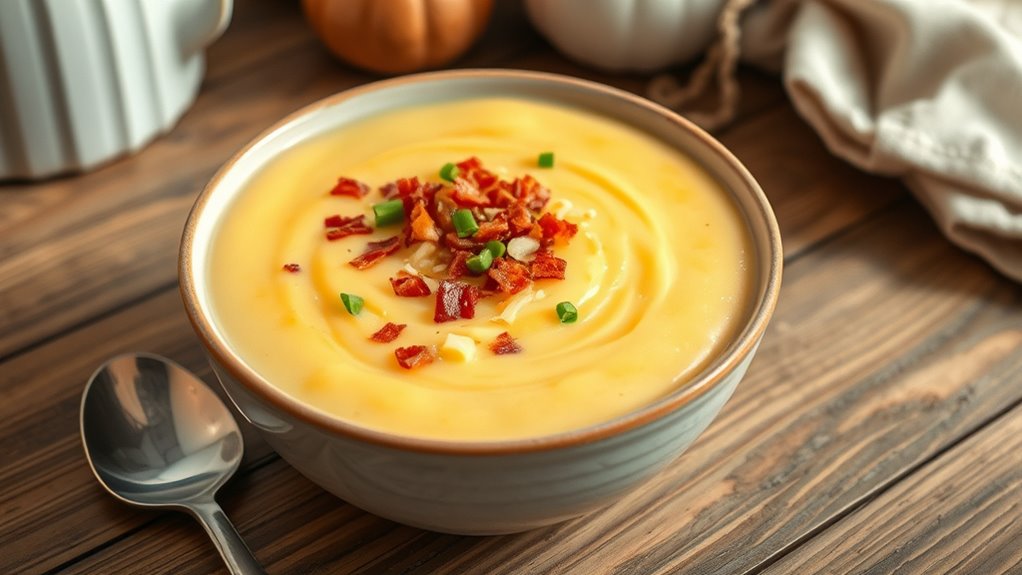This Paula Deen–inspired baked potato soup comes together with simple pantry staples, a smoky bacon and onion base, and a lush cream finish. You’ll start by browning bacon, sautéing onions and garlic, then whisk in flour for a glossy roux before adding stock and hefty potato chunks. Let it simmer until tender, stir in milk or cream, and finish with cheddar. For best flavor, top with chives or extra cheese—and you’ll discover more tips as you continue.
Ingredients and Quantity
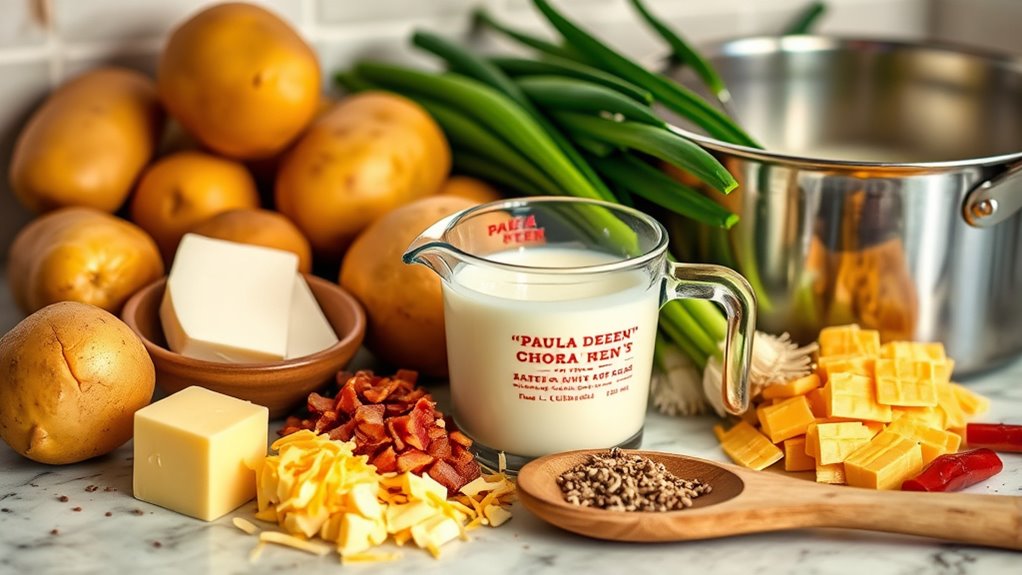
To make Baked Potato Soup, gather about 6 medium potatoes, 4 cups of broth, 1 cup milk or cream, 4 slices of bacon, 1 medium onion, 2 cloves garlic, and a cup of shredded cheddar.
You grab what you need and keep it simple: clean potatoes, chop them into chunks, and toast the bacon for flavor that carries. The base stays steady yet bold, ready for tweaks. Try a splash of cream for silk, or swap broth for a smoky stock to sharpen the pot. Baked potato goodness appears in every bite, with rustic texture and creamy depth. Soup variations let you tailor heat, dairy, or toppings to fit your mood. Explore, taste, adjust, and savor the freedom to craft your perfect bowl.
| Potato | Broth | Cream/Milk |
|---|---|---|
| 6 medium | 4 cups | 1 cup |
| Bacon | Onion | Garlic |
| 4 slices | 1 | 2 cloves |
Preparations
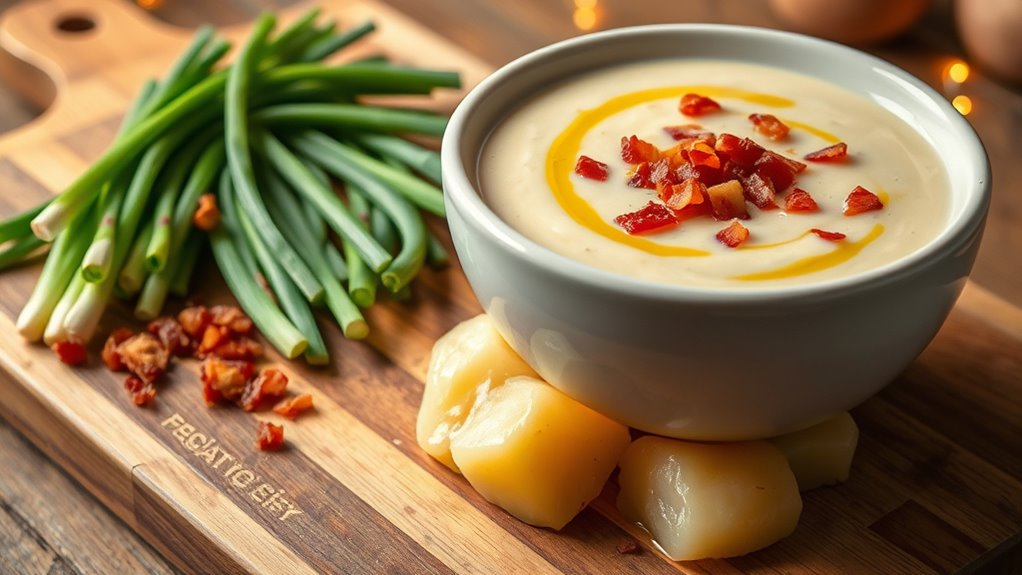
Start by prepping your potatoes: scrub them clean, then cut into evenly sized chunks so they’ll cook together. You’ll want bite-size pieces that hit the pot at the same time, so the texture stays creamy, not mushy. Dice onions and celery medium; a quick mince of garlic wakes the base without overpowering it. Sauté aromatics in butter until they glow, then stir in flour for a smooth roux that thickens without clumping. Add stock gradually, whisking to maintain a glossy finish. Simmer until potatoes are tender, then mash lightly for rustic body. For flavor enhancements, fold in half-and-half and cheddar, seasoning with salt, pepper, and a pinch of paprika. Preparation techniques here keep the soup rich, balanced, and ready to savor.
Kitchen tools or Kitchenware Required
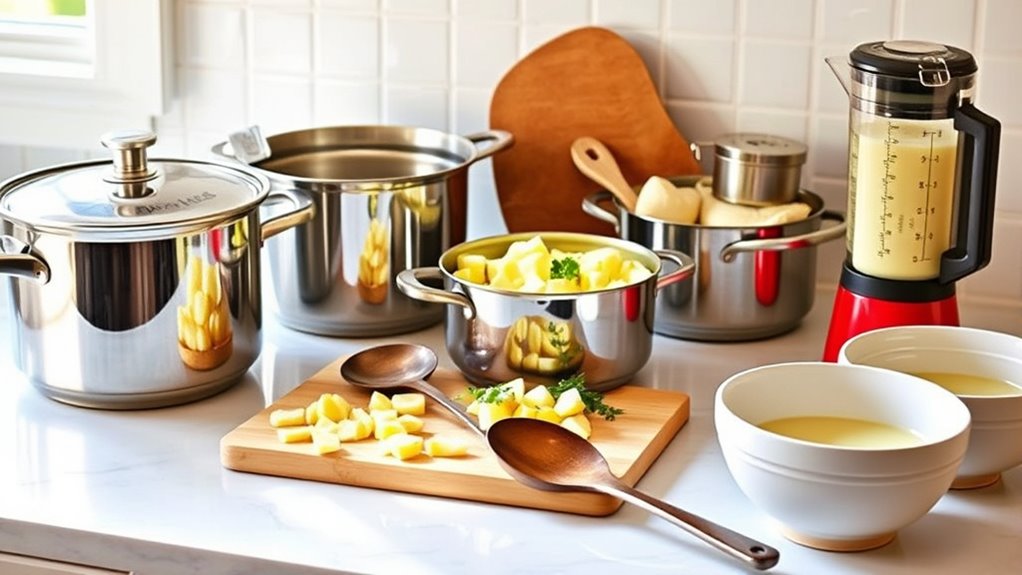
You’ll want a dependable lineup of kitchen tools that keep this soup moving smoothly: a sturdy sharp knife, a large cutting board, a heavy pot or Dutch oven, and a whisk to keep that roux glossy. You’ll also grab measuring cups and mixing bowls to portion ingredients precisely and whisk in creamy textures without clumps.
| Tool | Purpose | Tip |
|---|---|---|
| Measuring cups | Measure liquids and dry goods | Level for accuracy |
| Mixing bowls | Prep and combine ingredients | Use with a splash of confidence |
| Heavy pot/Dutch oven | Sauté, simmer, and thicken | Reserve a lid for gentle simmering |
| Sharp knife | Chop potatoes and toppings | Keep blades sharp for safety |
| Cutting board | Stable prep surface | Dry before slicing potatoes |
How to Cook
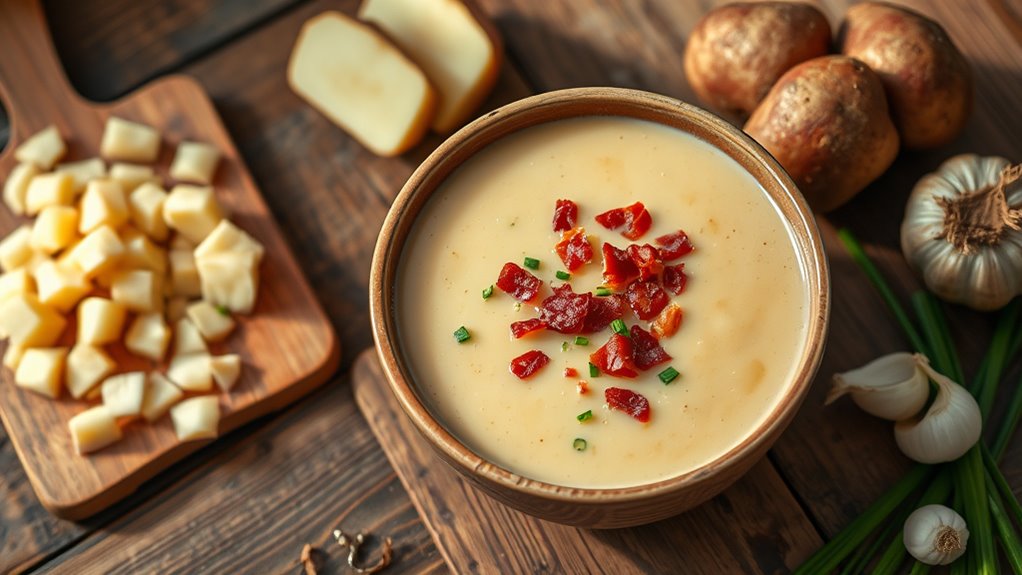
- Prepare your tools and ingredients.
- Wash and scrub russet potatoes until their skins are clean.
- Pat the potatoes dry and dice them into even chunks for uniform cooking.
- Heat a pot and add flavorful aromatics such as onion, garlic, and a pinch of salt.
- Pour in chicken or vegetable stock and bring to a simmer.
- Add the diced potatoes and cook until tender.
- Whisk in milk or cream to create a creamy texture.
- Maintain a gentle boil to blend the flavors, stirring occasionally to coat the spoon with starch.
- Reserve some corn kernels or bacon bits to add at the end for texture.
- Experiment with variations like baked potato, chive, or cheddar soup.
- Adjust the soup’s thickness by adding more stock as needed.
How to Serve
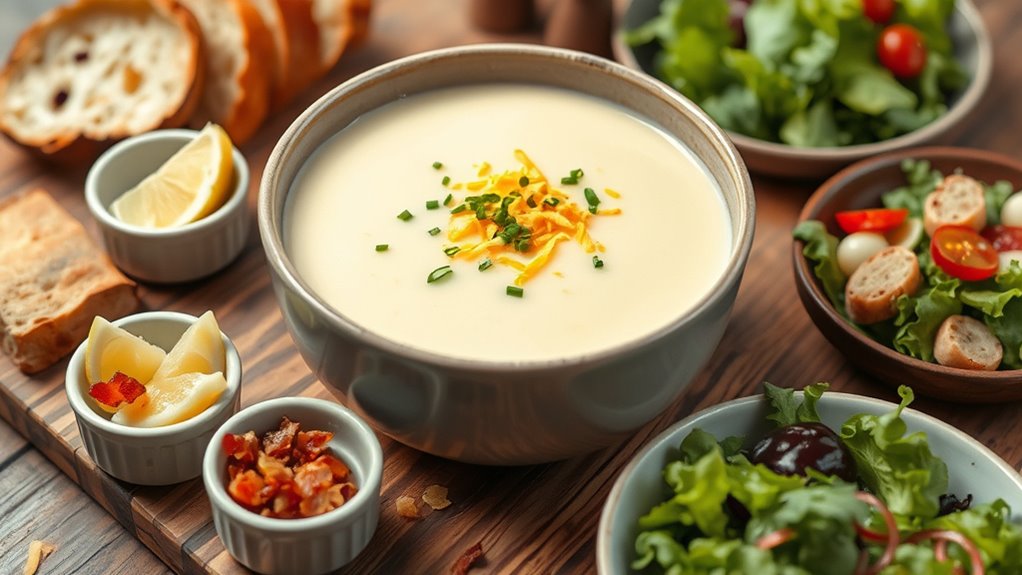
Potato soup is best served hot with toppings that add texture and brightness. You’ll finish each bowl with simple garnishes and smart serving choices that keep every bite satisfying. Start by offering a small ramekin of chopped chives, shredded cheese, and bacon bits so guests tailor their richness. Keep toppings in separate bowls to preserve potato creaminess until served. For texture lovers, offer crushed crispy potato skins or toasted breadcrumbs; for brightness, provide a squeeze of lemon or a dollop of sour cream. Serving suggestions include pairing with crusty bread or a light salad to balance richness. In-demand garnishing options should be easy to customize, letting everyone craft their perfect bowl. This approach blends comfort with freedom, practicality, and tasteful presentation.
Tips
If you want potato soup that’s consistently silky, start by warming your bowls—this prevents a sudden temperature drop that dulls flavor. For creaminess, gradually whisk in hot broth to avoid curdling, then fold in warm milk off the heat. Taste as you go, dialing salt and pepper to your preference, and add a pinch of smoked paprika for depth. For soup variations, swap in Greek yogurt or sour cream for tang, or blend a portion of potatoes for a thick, velvety texture. When it’s time to serve, offer toppings that invite customization—crisp bacon, chives, shredded cheese, or crisp potato skins. Involve your guests with serving suggestions that feel simple, satisfying, and truly freeing.
Food Value and Benefit
Baked potato soup is a comforting and practical dish that offers a range of nutritional benefits. Made with simple, wholesome ingredients, it provides essential vitamins and minerals while delivering satisfying flavor and texture.
Food Value:
- Potatoes are a rich source of complex carbohydrates, providing steady energy and dietary fiber that supports digestive health.
- They contain potassium, an important mineral for heart and muscle function.
- The soup includes milk or broth, contributing calcium for strong bones and hydration.
- The creamy texture comes naturally from simmered potato starch, avoiding heavy creams and excess fat.
- Toppings like scallions add vitamin K and vitamin C, while a small amount of cheese can provide protein and additional calcium.
Benefits of Eating Baked Potato Soup:
- Supports sustained energy release due to complex carbohydrates.
- Promotes digestive health through dietary fiber.
- Helps maintain healthy blood pressure with potassium content.
- Provides calcium that supports bone health.
- Offers hydration and electrolytes from broth or milk.
- Can help stabilize blood sugar levels when protein-rich toppings are added.
- Easily adaptable for dairy-free or vegan diets, making it inclusive for various nutritional needs.
- Low in unhealthy fats when prepared mindfully, aiding in weight management.
Vitamins and Minerals Present:
- Potassium
- Calcium
- Vitamin C (from scallions)
- Vitamin K (from scallions)
- Some B vitamins (from potatoes)
Frequently Asked Questions
Can I Make This Soup Dairy-Free or Vegan?
Yes, you can; swap dairy with dairy substitutes and choose vegan options. Use almond or oat milk, cashew cream, coconut milk, and olive oil. Add flavorful toppings, garlic, onions, and broth for a comforting, freedom-filled, dairy-free soup.
How Long Can Leftovers Be Stored Safely?
Leftovers keep safely in the fridge for 3–4 days. For longer storage, freeze them, labeling with date. When reheating, guarantee steaming hot throughout. Practice leftover storage hygiene and enjoy your practical, freedom-loving approach to safe consumption.
Can I Freeze the Soup for Later Meals?
Yes, you can freeze it. For best texture, cool fully, portion, and use airtight containers. Freezing tips: leave headspace, label, and thaw slowly. It fits your meal prep mindset, helping you savor freedom and plan ahead.
What Are Good Gluten-Free Substitutions for Thickening?
You can use gluten free thickeners like cornstarch, arrowroot, or xanthan gum, plus potato starch for ease; for gluten-free potato soup alternatives, try mashed beans or cauliflower puree to reach a creamy, comforting texture you’ll love.
Is This Potato Soup Spicy or Mild in Flavor?
This flavor profile is mild, with gentle potato warmth and creaminess; the spice level stays low unless you add peppers or hot sauce. You can tailor heat by gradual seasoning, keeping it approachable, savory, and freedom-loving.
